SUMMARY
This is AI generated summarization, which may have errors. For context, always refer to the full article.
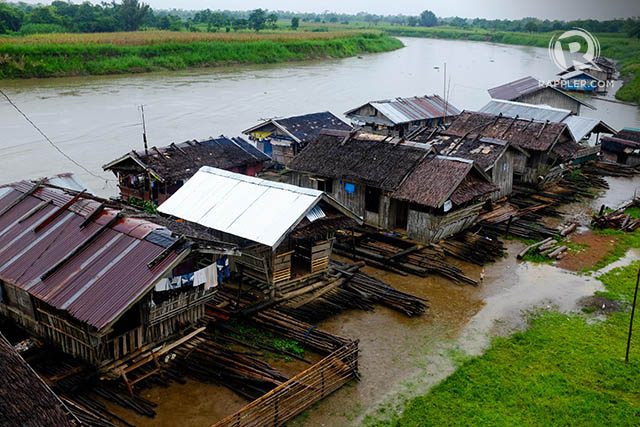
AGUSAN DEL SUR, Philippines – Seventy-seven-year-old Anito Goyo was busy tending her small patch garden on the eastern bank of the Agusan River when her house swayed and rolled with the waves created by the passing motorized canoe, announcing the arrival of one of her neighbors from the town.
She lives in Barangay Sabang-Gibong, which lies along the Agusan River, deep in the heart of the Agusan Marsh in the town of Talacogon, Agusan del Sur.
The Agusan River is the largest river basin in the Philippines, which stretches 350 kilometers from its headwaters in Compostela Valley and Davao Oriental, and drains to Butuan Bay in Butuan City.
Sabang-Gibong looked like a village trapped in time. Electricity was introduced only in September 2013.
Most of the houses in villages that lie along the Agusan River are on water. The houses here are made of bamboo and wood found in the area. The dry lands on river banks are farmed with corn, and old trees are abundant far into the marsh.
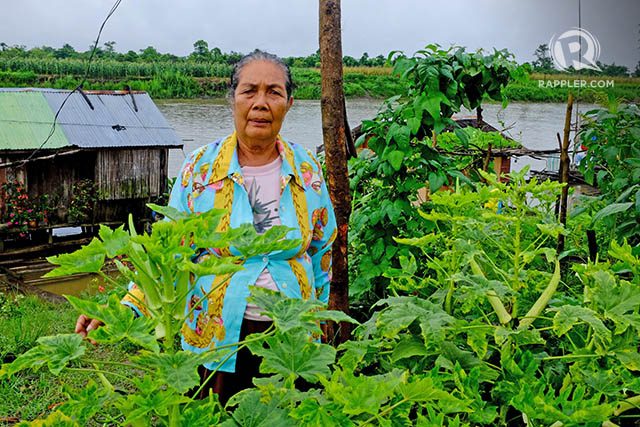
Climate sustainable houses
Goyo, a mother of 16 children, said that ever since she can remember, their houses here have kept them dry on water. Several houses are situated on dry land, but when the river rises, these will float too.
Almost all of the communities are on the river, which also serves as their main road in going to the nearest town – nearly 50 kilometers away. A three-hour boat ride, which is often dangerous, must be endured if one needs to travel outside their villages.
The Agusan River is treacherous. It looks calm on the surface, belying the strong underwater current and its depth.
The houses here have bundles of bamboos that serve as its base. According to resident Junrey Ocho, a bundle of bamboo could have 50 to a hundred bamboo poles. “Small houses can have three bundles; others have six bundles, depending on the size of the house,” Ocho said.
The bamboos would serve as ‘floaters’ for the houses. From the bundles of bamboos, the houses are then built and tied to the trees.
Datu Lindasan Wilhelmo Guluran, chieftain of the Manobo people here, says the forest provides them with materials to build their houses.
“We allow our people to cut trees for building their houses, but not for selling those trees,” he said.
Sabang-Gibong Chiarwoman Felipa Guluran said that in their village, there are 229 houses, with almost all of them on the river. The houses here are mostly single storey and have low ceiling for easy maintenance and quick towing when the flood waters would come.
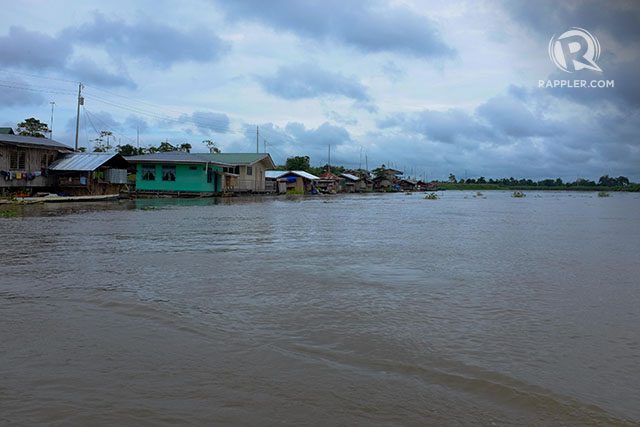
Flood month
Between December and March, the flood waters come and everything in sight is submerged in water. The Agusan River swallows and takes everything back, with as much as 10 meters of flood.
Datu Lindasan said that everything in sight disappears, “The River will take everything it has given,” he said.
Their barangay halls and schools – both raised up to 3 storeys high – are the two only permanent structures in their village. Everything else will float.
Goyo’s garden will be gone, along with the corn fields in the area.
“When the water comes, we will tie each houses into groups for better stability and strength,” Ocho said.
The edges of their floater will be tied with more bamboos to serve as their streets.
The villages then would have to endure the flood for 4 months. Their livelihood shifts from farming to fishing.
Ivy Ocho, Junrey’s wife, said that when the rainy season comes, they will have to stock food. The abundant fish will be smoked and dried. Livestocks are put in floating cages.
On a positive note, the annual flooding brings nourishment, which sustains their fertile land.
Their electricity will be cut off for the rest of the duration of the flood, and the village will turn into darkness – just like how it was before 2013.
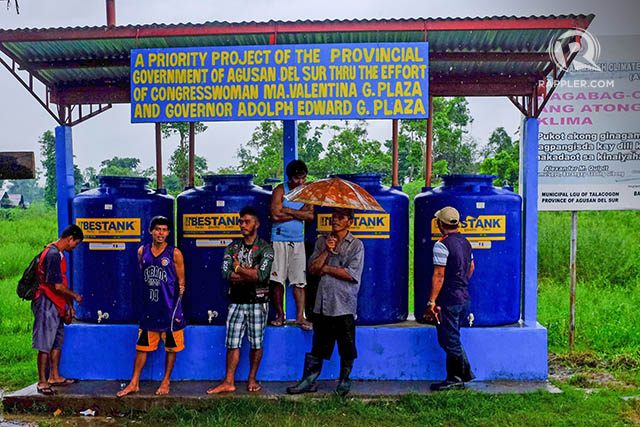
Rainwater harvesting
The irony is that they are surrounded by waters that they cannot drink. That’s why all houses here have rain water harvesting. Water containers of all sorts of size and volumes abound.
Goyo’s house has 4 water drums, among other sorts of water containers.
“You need those water containers to survive here. We need the rain for us to have something to drink,” Goyo said.
It is only recently that their community got a government project for Polyethylene water storage tanks. The rainwater from the barangay hall is collected to these tanks.
Goyo said that when she was young, the water from the river used to be drinkable. “Now, we cannot drink from it. It is dangerous because of the chemicals that seeps into the river,” Goyo said.
Their comfort room wastes are also directly flushed into the river.
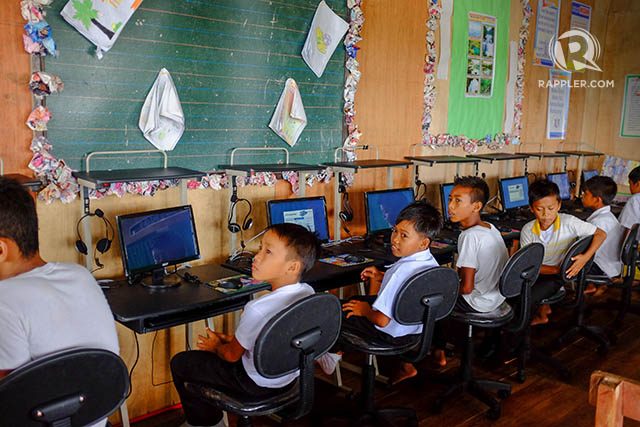
IT-empowered schools
The newly-constructed elementary school is a floor higher than the previous building due to recent changes in the height of flood water.
Solar panels are also constructed on the roof of the school to provide power during the rainy months.
Emily Sumipo, teacher-in-charge in Sabang-Gibong Elementary School, said they are thankful that the Agusan del Sur Electric Cooperative (ASELCO) has finally energized the village.
Along with the electricity comes the improvement in their work as teachers and in the lives of their students. The school is manned by 3 teachers and 1 volunteer teacher, who all take turn in teaching kindergarten to grade six.
The old elementary building, which only has 3 classrooms and is already worn out, is being used by the high school. The school has 10 new computers, donated by the Aboitiz Foundation on June 25.
Roy Rencunada of Aboitiz Power said that they are excited with the possibilities of learning for the people in the community. “They said that it takes a village to raise a child. This is Aboitiz Power and Aboitiz Foundation doing their part for a better future of the children,” he said.
It’s 11-year old Limbe Racasa’s first time to see a computer and he’s already excited to learn how to use one. “Will it break if we touch it? We only saw [computers] on books but we never got one,” Racasa said smiling.
The closest thing to a computer are the few Android phones that residents own since they already have electricity.
The excitement over the new computers has spilled over to the students’ parents too. For Marilyn Tormento, computers can help her and her children.
“It would add knowledge to us. They say you can see the world with the computers,” Tormento said, smiling shyly.
Even local barangay officials want a piece of the new technology. “It used to be that we need to go to the town to have our documents encoded and printed. Now I think we can do it here,” Guluran said.
The school is thinking of setting up a schedule so both the young and old get a chance to use the new computers. – Bobby Lagsa/Rappler.com
Add a comment
How does this make you feel?
There are no comments yet. Add your comment to start the conversation.